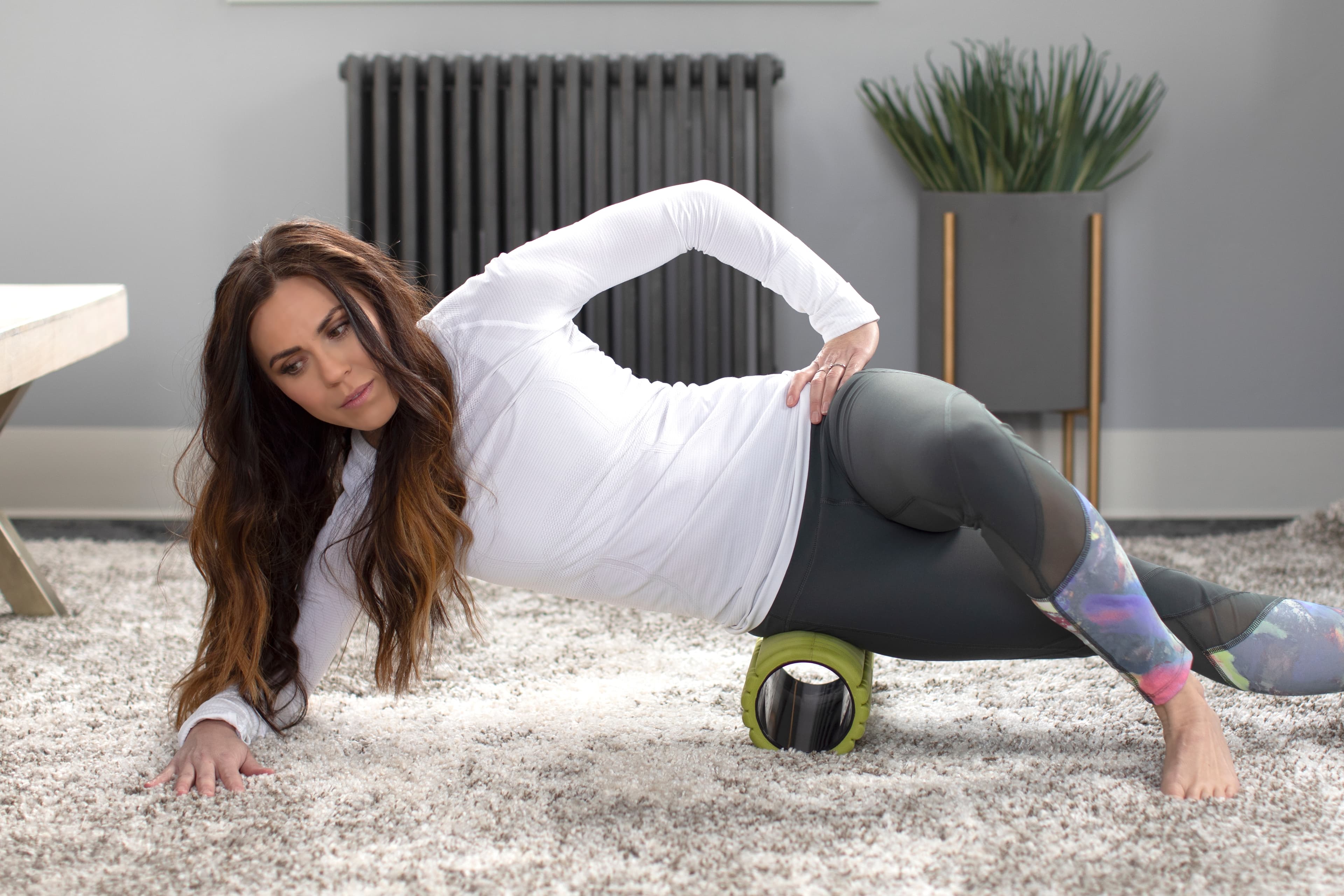
SMR, also known as foam rolling, is a technique specifically targeting these fascial systems that have been negatively impacted through repetitive motions, poor posture, and improper exercise techniques. This cycle starts out with inflammation which then leads to the development of soft tissue adhesions “knots or trigger points” and therefore, limiting range of motion.
Benefits of SMR.
- Helps to improve range of motion
- Decreases effects of stress on the human movement system
- Aids in correcting muscle imbalances
- Increases blood flow to aid in overall recovery
- Reduces soreness
When should it be done?
SMR should be done before any type of static or dynamic stretching. When done first, the SMR helps the muscle tissue to lengthen while you engage in the other stretching afterward. Ideally, you should be foam rolling every single day.
How to do it correctly.
Relax your body while slowly rolling along the muscle you are targeting. It is important to keep the muscle relaxed. Once you hit a “trigger point” or area that is sore, stop rolling and remain on that point for 30–90 seconds. You will then feel the “trigger point” release, thus successfully completing self-myofascial release for that specific area. Some muscles will have muscle trigger points, so take your time and do not rush. After successfully doing SMR, you will notice that the number of trigger points you have is decreasing and it will start to become less uncomfortable.
- Tip #1: Maintain core activation while foam rolling. This will aid in the activation of the correct muscles and help you keep the correct posture.
- Tip #2: Avoid rolling over any joints or bones. This can lead to injury.
- Tip #3: Some muscles may require that you use more or less pressure while rolling. Listen to your body and adjust pressure accordingly.
Calves (gastrocnemius and soleus)
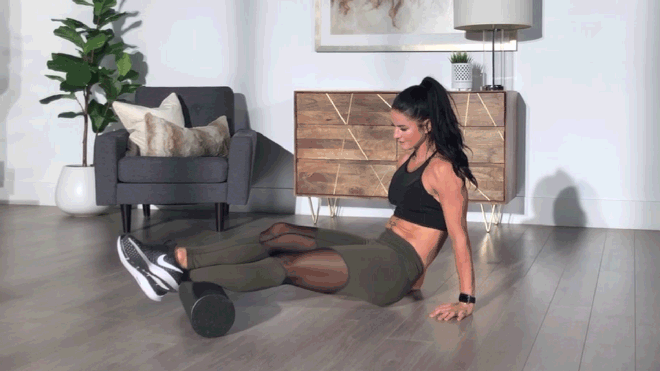
Start by sitting on your glutes. Place the foam roller under your calves. Use your hands to assist as you gradually elevate your body while activating your core. Slowly roll across your calves, targeting any “trigger points” you may find. Cross one leg over the other to increase pressure if needed.
Hamstrings
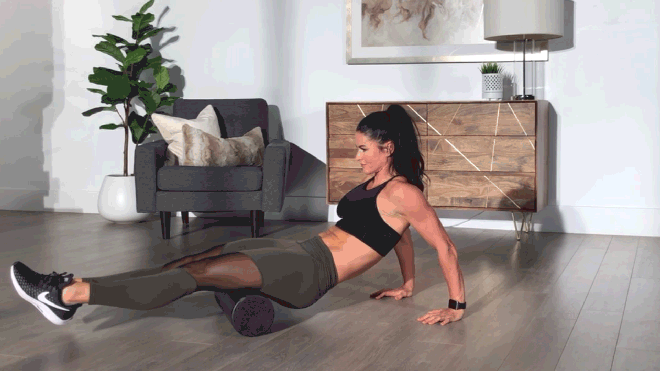
Start by sitting on your glutes. Place the foam roller directly under your extended leg where your hamstrings meet your glutes, with the other leg bent to a 90-degree angle. Use your hands to assist as you gradually elevate your body while activating your core. Start by slowly rolling backward. Finish rolling directly above the back of your knee.
Quadriceps
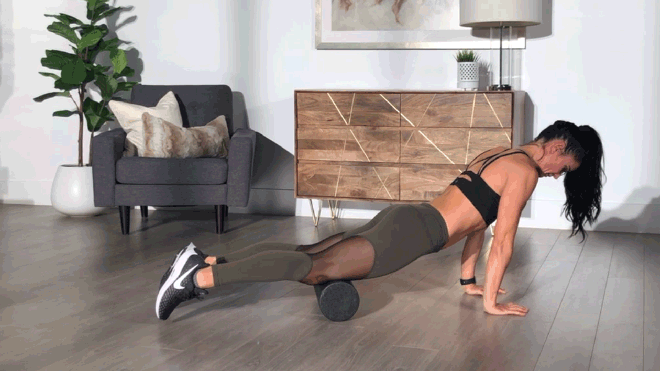
Start by laying down on your stomach. Place the foam roller under your leg, starting below your hip joint. Press your body up on your forearms while activating your core. Slowly roll your body forward until you finish directly above the knee.
IT Band
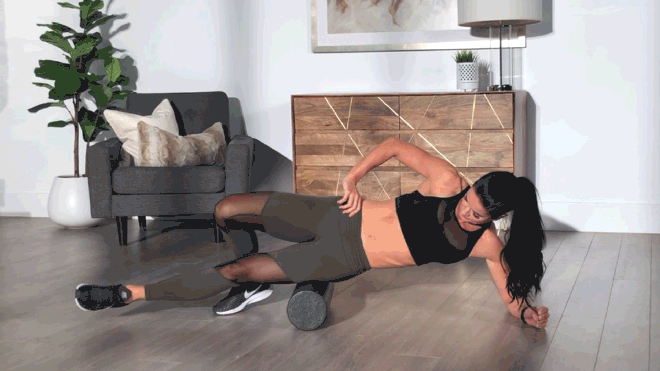
Lay on your side, place the foam roller on the outer thigh/IT band while supporting your body weight with your arms and legs. Starting at the base of your outer leg, by your hip, slowly roll back and forth along the length of the outer leg.
Glutes
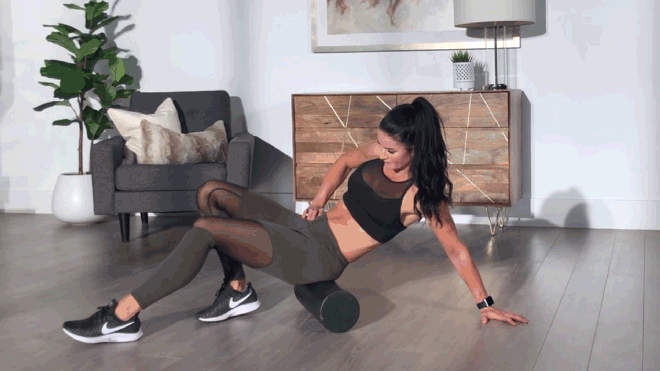
Place foam roller below the glutes (essentially, sit on the foam roller). Using your arms to support your body, slowly roll back and forth along the glutes. Keep in mind that your glutes may need extra attention, as they are a key muscle group for mobility, stability, and posture.
Latissimus Dorsi (lats)
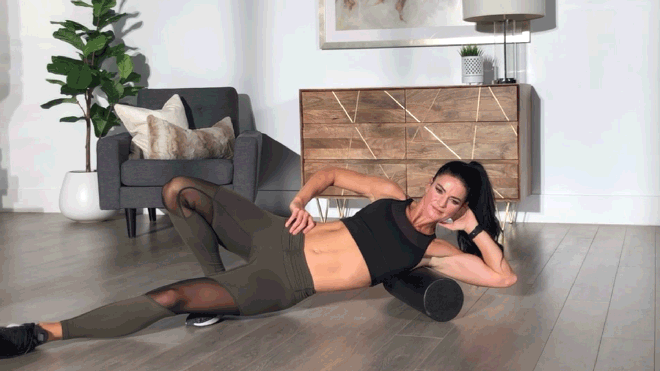
Start by lying on your side with your arm extended. Place the foam roller perpendicular to your body under your armpit. Slowly roll back and forth along the side of your torso until you find a tender spot. This may take some practice or feel a little awkward at first but will help loosen up those muscles that are often difficult to target.
Thoracic Spine (upper back)
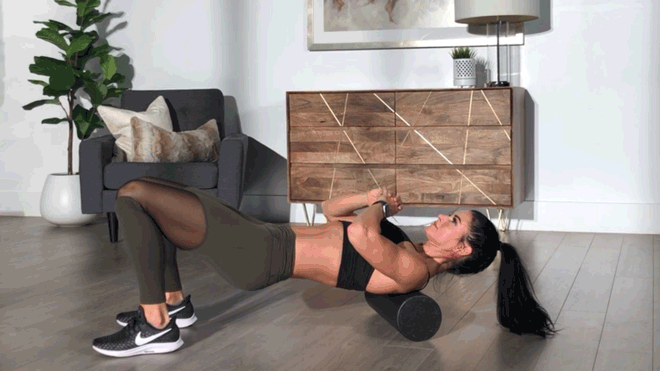
Place the foam roller under your mid-back while laying on the ground. Next, lift your glutes off the ground in a half bridging position by engaging your core and pulling your belly button to your spine. Put your hands behind your ears, with your elbows facing out. The goal is to have your chest open up. Slowly roll along your thoracic spine (upper back), stopping at each trigger point you may find.
There you have it! SMF (foam rolling) is a great tool to use not only as recovery after a workout but should be added as part of your everyday routine. Keep rolling!
You might also like

iFIT x F45: Studio Training Now Streaming on iFIT
iFIT teamed up with F45 Training to bring you an exciting fitness collaboration: iFIT members now have access to F45 Training’s most popular studio workouts and brand-new iFIT x F45 originals. Whether you’re looking for high-energy cardio, strength-based training, or seeking recovery sessions, you now have it all in the iFIT Library.Earn a free F45 Training studio class each monthBeginning January 8, 2026, if you complete any F45 Training workout on iFIT, you’ll receive a promo code for a free in-person F45 class at a participating studio.* Here’s how it works:Complete at least one F45 Training workout on iFIT during the month.If you’re eligible, you’ll receive an email with a promo code to redeem an F45 Training class in studio.You can earn this reward once per month as long as you stay engaged with F45 Training content on iFIT.See what F45 Training has to offerNow, iFIT members can access the world-renowned energy and structure of F45 Training’s signature formats- all from the comfort of your own home. Here’s what you’ll find:Licensed F45 Training contentYou can now access a collection of F45 Training series based on their most popular formats, including:Athletica: high-energy cardioRomans: targeted strength trainingMarathon: cardio enduranceThe Nines: hybrid conditioningMondrian: stretching and recoveryOriginal iFIT x F45 seriesIn addition to the licensed F45 Training content, you also have access to brand-new series co-created with F45 Training. Each series is guided by iFIT Trainers Hannah Eden and John Peel alongside F45 trainers. These workouts offer the best of both worlds: F45 Training signature workouts alongside the iFIT coaching you know and love. These new series include:iFIT x F45: Cardio Series: AthleticaiFIT x F45: Resistance Series: RomansiFIT x F45: Hybrid Series: CheckmateWhether you’re looking to level up your routine or just get back into fitness, there is a series for you. The iFIT x F45 Training partnership unlocks a new world of training for you, all on iFIT.*Offer valid for iFIT athletes who complete iFITxF45 or F45 qualifying workouts within the same calendar month. Limit one code per user per month. Code valid for one (1) drop-in class at participating studios. Code has no cash value and must be redeemed in the month earned. Class availability not guaranteed. Once redeemed, class cannot be cancelled and rebooked using the same code; studio cancellation and no-show fees may apply. Offer is non-transferable and may be modified or ended at any time. For redemption issues, contact support@f45training.comDisclaimer: The primary purpose of this blog post is to inform and entertain. Nothing on the post constitutes or is intended to be a substitute for professional medical advice, prevention, diagnosis, or treatment. Reliance on any information provided on the blog is solely at your own risk. Always seek the advice of your physician or other qualified health provider with any questions you may have regarding a medical condition, and please consult your doctor or other health care provider before making any changes to your diet, sleep methods, daily activity, or fitness routine. Do not disregard professional medical advice or delay seeking it because of information available on this blog. NordicTrack assumes no responsibility for any personal injury or damage sustained by any recommendations, opinions, or advice given in this article. Always follow the safety precautions included in the owner’s manual of your fitness equipment.
December 8, 2025

Find Your Stride with Tommy Rivs in the Redwoods Walk to Run Series
There’s just something magical about taking your next step forward, especially when it means you’re surrounded by the towering redwoods and rugged beauty of California’s northern coast. iFIT Trainer Tommy Rivs’ newest series will help you experience the magic of this region with the Redwoods Walk to Run Series. This beginner-friendly program is designed to help you progress from walking to running at your own pace.Explore California’s Scenic Coast Set along breathtaking coastal trails and through scenic redwood groves, this series brings the natural beauty of Northern California to your treadmill. From the peaceful paths of Laguna Point to the rolling meadows of Mendocino Headlands, each workout is an opportunity to breathe, move, and connect with the pure joy of movement.Make Progress with Tommy RivsKnown for his thoughtful coaching and love of movement, Tommy Rivs will guide you through a mix of walking and running intervals to gradually build your endurance and confidence. Each workout keeps the speed steady while changing your movement so you can focus on how your body feels and adapts as you move.Whether you’re returning to fitness or taking your first steps toward running, this series is all about moving forward with purpose. Tommy will help you to:Develop endurance and build strength with progressive intervalsImprove your form and consistency with his expert guidanceReconnect with the joy of movement in an inspiring settingBuild confidence to take on your next running challengeThis is only the beginning; there’s so much more to come with Rivs. For now, lace up those shoes and join him for an incredible journey amongst the redwoods.Join Tommy Rivs in the Redwoods
November 3, 2025
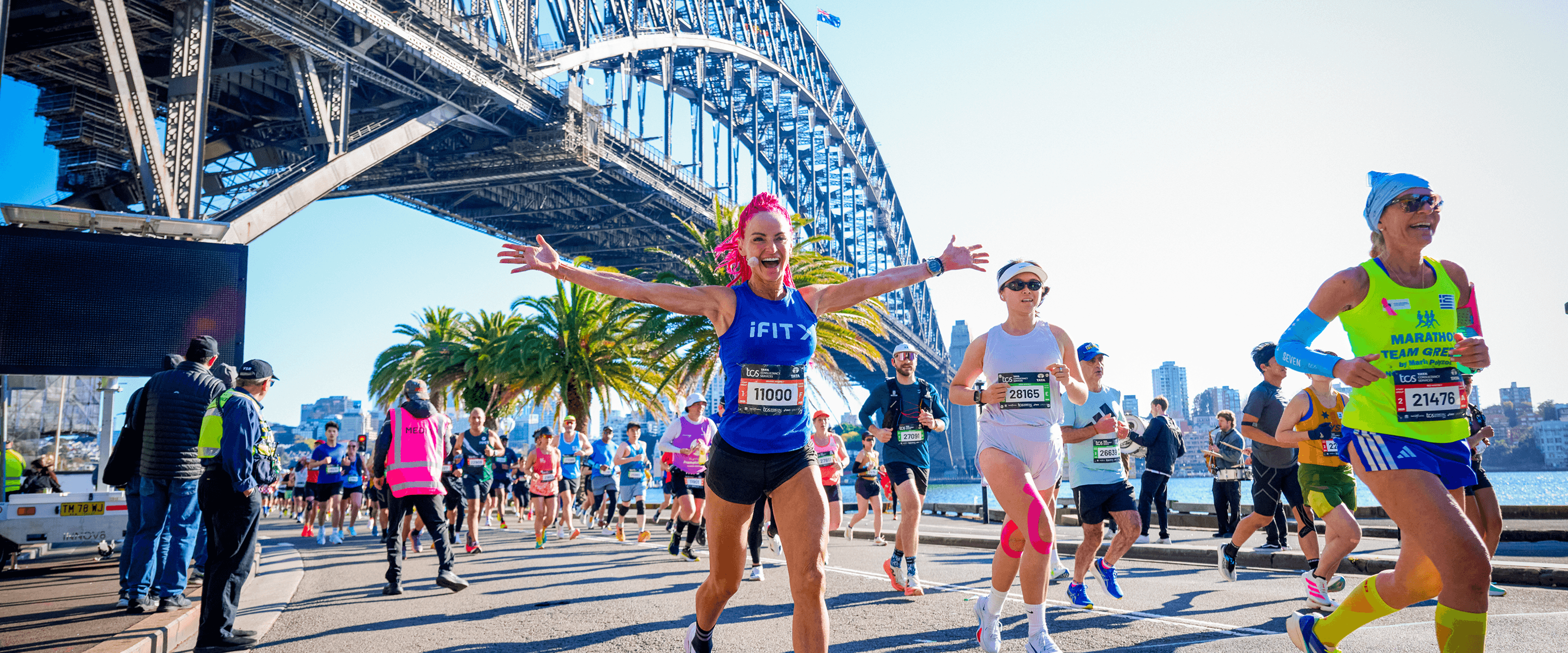
Enter iFIT’s Second Chance Marathon Contest for a Chance to Run the 2026 TCS Sydney Marathon presented by ASICS
Win an entry in the 2026 TCS Sydney Marathon presented by ASICS, with team iFIT!2025 marked a defining moment for Australian sport, as the TCS Sydney Marathon became the seventh Abbott World Marathon Major, joining the ranks of the world’s most prestigious races. As the Official Fitness Training Partner, iFIT captured the event in full, filming the entire course to bring Sydney’s streets to life for runners around the world. Guided by iFIT Trainer Ashley Paulson, the marathon was transformed into an immersive workout, from the Harbour Bridge to the Opera House, giving iFIT members the chance to experience the race virtually on their NordicTrack treadmills within just 24 hours of the finish line.This year, iFIT is helping more runners turn their marathon goals into realities by giving them the chance to secure an entry into the 2026 TCS Sydney Marathon presented by ASICS. Five runners will earn their place on the start line and cross the finish line with Team iFIT, receiving a custom training guide and mentorship from iFIT Trainers to help them every step of the way!The winners of the iFIT Second Chance Marathon Contest for a Chance to run the 2026 TCS Sydney Marathon presented by ASICS are:Matthew ScottGareth RusselKate MaconachieMaria Bozena NowakMilena RadoychevaHow to apply and what we’re looking forTell us why YOU deserve a place in the 2026 TCS Sydney Marathon presented by ASICS, and what it would mean to take on this challenge with Team iFIT by your side. We’re looking for authentic stories, passion for running, and the drive to be part of something bigger. Submit your response HERE.Details and contest rules The Contest begins on November 10, 2025, at 12:01 a.m. Pacific Time (“PT”) and ends on November 16, 2025, at 11:59 p.m. PT. Click here for the Official Rules. Applications to be submitted through this form.Upon the completion of the Contest Entry Period, a panel comprised of members of Sponsor’s staff will review the Entries. Sponsor will select up to five (5) winners. Winners will be notified using the email address provided with the entrant’s Entry.The fifty (50) United States (and the District of Columbia); Canada; Mexico; the United Kingdom; France; Germany; Spain; New Zealand; and Australia.Disclaimer: The primary purpose of this blog post is to inform and entertain. Nothing on the post constitutes or is intended to be a substitute for professional medical advice, prevention, diagnosis, or treatment. Reliance on any information provided on the blog is solely at your own risk. Always seek the advice of your physician or other qualified health provider with any questions you may have regarding a medical condition, and please consult your doctor or other health care provider before making any changes to your diet, sleep methods, daily activity, or fitness routine. Do not disregard professional medical advice or delay seeking it because of information available on this blog. NordicTrack assumes no responsibility for any personal injury or damage sustained by any recommendations, opinions, or advice given in this article. Always follow the safety precautions included in the owner’s manual of your fitness equipment.
November 9, 2025